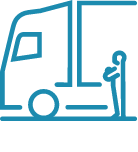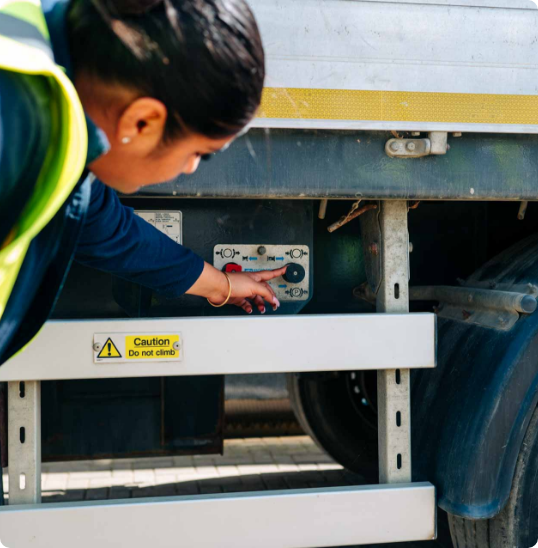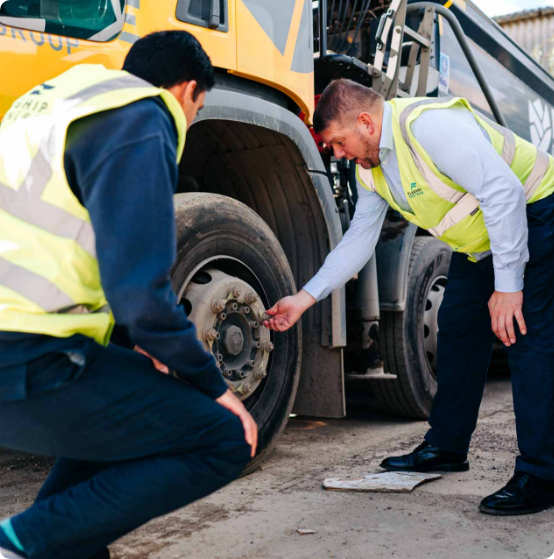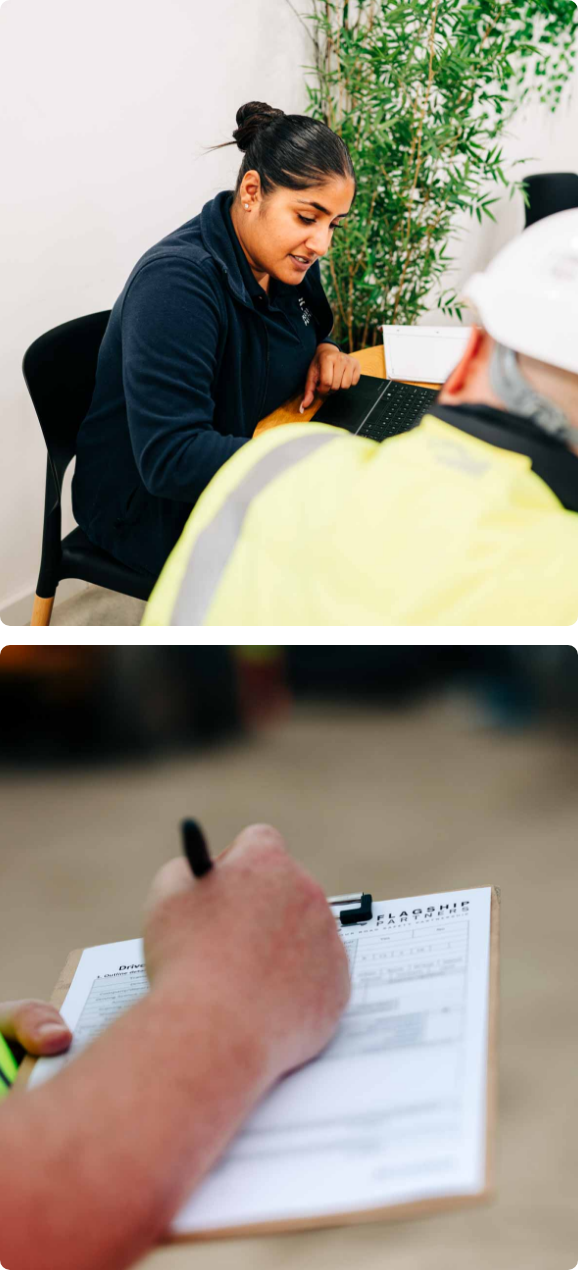Consultancy / Fleet
Workshop Audit Services

In an industry where safety and standards cannot be compromised, the need for foresight and proactive management is paramount. Our services are tailored not just to meet but exceed the expectations and requirements of our clients, ensuring their operations are not just compliant but exemplary. From compliance offerings to our specialised workshop audits, we provide comprehensive support that safeguards our clients’ futures, ensuring they are always a step ahead.

Understanding Workshop Audits
Workshop Audits are a critical component in the realm of vehicle maintenance, acting as a preventive measure that ensures the highest standards of safety, compliance, and efficiency within an operator’s maintenance practices. These audits are not just inspections; they are comprehensive evaluations designed to scrutinise every aspect of workshop operations, from technician competence to the condition and calibration of equipment. By identifying potential issues before they become problematic, Workshop Audits play a pivotal role in maintaining operational integrity and reliability.
At the heart of Flagship’s Workshop Audits is a commitment to excellence and proactive management. These audits are an integral part of our broader compliance offerings, designed to complement and enhance our clients’ ability to manage their maintenance operations effectively. Through our Workshop Audits, we offer a meticulous assessment conducted by experts well-versed in the nuances of safe workshop practices and the high standards required in vehicle maintenance workshops.
The Scope of Workshop Audits
The scope of a Workshop Audit is broad and tailored to address the specific needs and challenges of each operator. Key areas of focus include:

Technician Competence
Evaluating the skills, knowledge, and qualifications of technicians to ensure they are capable of performing their duties to the highest standards.
Safe Working Practices
Assessing the adherence to safety protocols and practices within the workshop to protect both staff and assets.
Calibration
Checking the calibration of diagnostic and repair equipment to ensure that it meets the required standards for accuracy and reliability.
Vehicle Equipment Condition
Inspect the condition of vehicle maintenance equipment to ensure it is fit for purpose, well-maintained, and capable of performing accurate and reliable service.
Subcontractor and External Maintenance Provider Audits
Extending the audit to include any external subcontractors or maintenance providers used by the operator, ensuring their compliance with the same high standards expected of in-house operations.
Why Workshop Audits Matter
For operators, the benefits of conducting regular Workshop Audits are manifold. These audits not only offer peace of mind by ensuring that all aspects of vehicle maintenance are managed proactively but also position operators favourably for DVSA (Driver and Vehicle Standards Agency) investigations and help in meeting the requirements of the DVSA recognition scheme. Furthermore, they underscore the operator’s commitment to safety and compliance, enhancing their reputation within the industry.

What Does a Workshop Audit Involve?
A Workshop Audit by Flagship is a thorough and systematic examination designed to ensure that vehicle maintenance operations adhere to the highest standards of safety, efficiency, and regulatory compliance. It is a multifaceted process that scrutinises every aspect of a workshop’s functioning, from the competence of its technicians to the condition and calibration of its equipment. Here’s a closer look at the key components and steps involved in a Flagship Workshop Audit.

Technician Competence Evaluation
The first pillar of a Workshop Audit involves assessing the skills, knowledge, and qualifications of the technicians. This evaluation ensures that all personnel are adequately trained and capable of performing their duties to the standards required for safe and efficient vehicle maintenance. It includes verifying certifications, ongoing training programmes, and practical skills assessments.
Safe Working Practices Assessment
Safety is paramount in vehicle maintenance workshops. The audit includes a comprehensive review of the workshop’s adherence to safe working practices. This encompasses everything from the use of personal protective equipment (PPE) and safety signage to the implementation of emergency procedures and the maintenance of transparent, unobstructed workspaces. The goal is to identify any potential hazards and recommend improvements to ensure a safe working environment for all employees.
Vehicle Equipment Condition Check
The condition of vehicle maintenance equipment is critical for the reliable performance of service tasks. Auditors inspect equipment to ensure it is in good working order, properly maintained and suitable for the functions it is used for. This includes lifting equipment, diagnostic tools, and other machinery used in the workshop, ensuring they meet industry standards and manufacturer specifications.
Calibration Verification
Accurate calibration of diagnostic and repair equipment is essential for effective vehicle maintenance. The audit verifies that all equipment is correctly calibrated, following manufacturer guidelines and industry best practices. This ensures that diagnostic readings are accurate and that repairs and maintenance are carried out with precision, maintaining the safety and reliability of vehicles serviced in the workshop.
External Subcontractor and Maintenance Provider Audits
For operators who use external subcontractors or maintenance providers, the Workshop Audit extends to these entities to ensure they also meet the required standards. This part of the audit assesses the quality of work, adherence to safety protocols, and overall compliance of third-party providers, ensuring consistency in the standards of vehicle maintenance across all service points.
Reporting and Recommendations
Following the comprehensive assessment, Flagship provides a detailed report outlining the findings of the audit. This report includes any identified issues, potential risks, and areas for improvement. Alongside the findings, Flagship offers practical, actionable recommendations to address these issues, enhance safety and efficiency, and ensure compliance with all relevant regulations.
Follow-Up and Support
Flagship’s commitment to excellence extends beyond the audit itself. Following the delivery of the audit report, operators have access to follow-up support to help implement the recommended improvements. This ongoing support is a testament to Flagship’s dedication to elevating standards in vehicle maintenance workshops and ensuring the long-term success and compliance of its clients.
Workshop Audit Process
The Workshop Audit process by Flagship is meticulously designed to ensure comprehensive evaluation and enhancement of vehicle maintenance workshops. This process is structured to be thorough yet efficient, ensuring minimal disruption to daily operations while providing valuable insights and recommendations for improvement. Here’s an in-depth look at the step-by-step process involved in conducting a Workshop Audit with Flagship.

1. Initial Consultation
The audit process begins with an initial consultation between the operator and Flagship’s audit team. This meeting is crucial for understanding the operator’s specific needs, the scope of the workshop operations, and any particular areas of concern. It also provides an opportunity to discuss the audit’s logistics, including scheduling and any preparation required from the operator’s side.
3. On-Site Audit
The on-site audit is the core of the process, where Flagship’s experts conduct a detailed examination of the workshop’s operations. This includes:
Technician Competence Evaluation:
Assessing the qualifications and skills of the technicians through interviews and observation.
Safe Working Practices Assessment:
Examining the implementation of safety protocols and practices within the workshop environment.
Vehicle Equipment Condition Check:
Inspect the maintenance equipment to ensure it is in proper working order and maintained according to standards.
Calibration Verification:
Checking the calibration of diagnostic and repair equipment to ensure accuracy and reliability.
During the on-site audit, auditors may also observe maintenance procedures, review job documentation, and assess the overall workflow and efficiency of the workshop.
7. Duration and Costs
A typical Workshop Audit by Flagship takes between 2 to 4 hours, depending on the size and complexity of the workshop. The cost of the audit is from £495, which includes the pre-audit review, on-site audit, detailed reporting, and follow-up support.
2. Pre-Audit Documentation Review
Before the on-site visit, the Flagship team conducts a review of the workshop’s documentation. This includes safety policies, maintenance records, technician qualifications, and compliance certifications. The purpose of this review is to gain preliminary insights into the workshop’s operations and compliance status, guiding the focus areas for the on-site audit.
4. Detailed Reporting
Following the on-site audit, Flagship compiles a comprehensive audit report. This report details the findings from the audit, highlighting areas of compliance as well as areas needing improvement. It includes specific observations, potential risks identified, and recommendations for corrective actions to address any issues. The report is designed to be actionable, providing a clear roadmap for enhancing workshop standards and compliance.
5. Recommendations and Action Plan
Alongside the detailed report, Flagship provides tailored recommendations and an action plan. This plan prioritises the improvements based on their impact on safety, compliance, and efficiency. It also offers guidance on implementing these recommendations, including timelines, resources needed, and best practice guidelines.
6. Follow-up and Continuous Improvement
The audit process does not conclude with the delivery of the report and recommendations. Flagship offers follow-up support to assist operators in implementing the suggested improvements. This may include additional consultations, training sessions for technicians, or further assessments to monitor progress. The goal is to ensure continuous improvement and sustained compliance with industry standards.
1. Initial Consultation
The audit process begins with an initial consultation between the operator and Flagship’s audit team. This meeting is crucial for understanding the operator’s specific needs, the scope of the workshop operations, and any particular areas of concern. It also provides an opportunity to discuss the audit’s logistics, including scheduling and any preparation required from the operator’s side.
2. Pre-Audit Documentation Review
Before the on-site visit, the Flagship team conducts a review of the workshop’s documentation. This includes safety policies, maintenance records, technician qualifications, and compliance certifications. The purpose of this review is to gain preliminary insights into the workshop’s operations and compliance status, guiding the focus areas for the on-site audit.
3. On-Site Audit
The on-site audit is the core of the process, where Flagship’s experts conduct a detailed examination of the workshop’s operations. This includes:
Technician Competence Evaluation:
Assessing the qualifications and skills of the technicians through interviews and observation.
Safe Working Practices Assessment:
Examining the implementation of safety protocols and practices within the workshop environment.
Vehicle Equipment Condition Check:
Inspect the maintenance equipment to ensure it is in proper working order and maintained according to standards.
Calibration Verification:
Checking the calibration of diagnostic and repair equipment to ensure accuracy and reliability.
During the on-site audit, auditors may also observe maintenance procedures, review job documentation, and assess the overall workflow and efficiency of the workshop.
4. Detailed Reporting
Following the on-site audit, Flagship compiles a comprehensive audit report. This report details the findings from the audit, highlighting areas of compliance as well as areas needing improvement. It includes specific observations, potential risks identified, and recommendations for corrective actions to address any issues. The report is designed to be actionable, providing a clear roadmap for enhancing workshop standards and compliance.
5. Recommendations and Action Plan
Alongside the detailed report, Flagship provides tailored recommendations and an action plan. This plan prioritises the improvements based on their impact on safety, compliance, and efficiency. It also offers guidance on implementing these recommendations, including timelines, resources needed, and best practice guidelines.
6. Follow-up and Continuous Improvement
The audit process does not conclude with the delivery of the report and recommendations. Flagship offers follow-up support to assist operators in implementing the suggested improvements. This may include additional consultations, training sessions for technicians, or further assessments to monitor progress. The goal is to ensure continuous improvement and sustained compliance with industry standards.
7. Duration and Costs
A typical Workshop Audit by Flagship takes between 2 to 4 hours, depending on the size and complexity of the workshop. The cost of the audit is £495, which includes the pre-audit review, on-site audit, detailed reporting, and follow-up support.
Take the Next Step Towards Excellence
Take action today to secure your position as a leader in vehicle maintenance excellence. Contact Flagship to schedule your Workshop Audit and embark on a path to continuous improvement and operational success. With our proactive approach and specialist expertise, we are here to support you in navigating the complexities of workshop management, ensuring your operations not only meet but exceed industry standards.